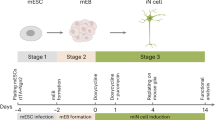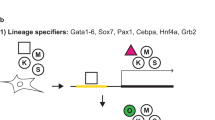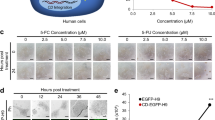Abstract
The generation of induced pluripotent stem (iPS) cells from mouse and human somatic cells by expression of defined transcription factors (Oct4, Sox2, c-Myc, Klf4, Nanog and Lin28) is a powerful tool for conducting basic research and investigating the potential of these cells for replacement therapies. In our laboratory, iPS cells have been generated from adult mouse neural stem cells (NSCs) by ectopic expression of either Oct4 alone (one factor; 1F) or Oct4 plus Klf4 (two factors; 2F). Successful reprogramming of mouse NSCs by 1F or 2F depends on endogenous expression of Sox2, Klf4 and c-Myc. Direct reprogramming of somatic stem cells to 1F or 2F iPS cells avoids expression of the oncogenes Klf4 and c-Myc and, hence, the development of tumors in chimeras and offspring derived from these cells. Here we present a detailed protocol for the derivation of NSCs from adult mouse brain (which takes 4 weeks), and generation of 1F (4–5 weeks) or 2F iPS cells (2–3 weeks) from adult mouse NSCs.
This is a preview of subscription content, access via your institution
Access options
Subscribe to this journal
Receive 12 print issues and online access
$259.00 per year
only $21.58 per issue
Buy this article
- Purchase on Springer Link
- Instant access to full article PDF
Prices may be subject to local taxes which are calculated during checkout




Similar content being viewed by others
References
Takahashi, K. & Yamanaka, S. Induction of pluripotent stem cells from mouse embryonic and adult fibroblast cultures by defined factors. Cell 126, 663–676 (2006).
Okita, K., Ichisaka, T. & Yamanaka, S. Generation of germline-competent induced pluripotent stem cells. Nature 448, 313–317 (2007).
Wernig, M. et al. In vitro reprogramming of fibroblasts into a pluripotent ES-cell-like state. Nature 448, 318–324 (2007).
Maherali, N. et al. Directly reprogrammed fibroblasts show global epigenetic remodeling and widespread tissue contribution. Cell Stem Cell 1, 55–70 (2007).
Takahashi, K. et al. Induction of pluripotent stem cells from adult human fibroblasts by defined factors. Cell 131, 861–872 (2007).
Yu, J. et al. Induced pluripotent stem cell lines derived from human somatic cells. Science 318, 1917–1920 (2007).
Park, I.H. et al. Reprogramming of human somatic cells to pluripotency with defined factors. Nature 451, 141–146 (2008).
Lowry, W.E. et al. Generation of human induced pluripotent stem cells from dermal fibroblasts. Proc. Natl. Acad. Sci. USA 105, 2883–2888 (2008).
Dimos, J.T. et al. Induced pluripotent stem cells generated from patients with ALS can be differentiated into motor neurons. Science 321, 1218–1221 (2008).
Nakagawa, M. et al. Generation of induced pluripotent stem cells without Myc from mouse and human fibroblasts. Nat. Biotechnol. 26, 101–106 (2008).
Kim, J.B. et al. Pluripotent stem cells induced from adult neural stem cells by reprogramming with two factors. Nature 454, 646–650 (2008).
Kim, J.B. et al. Oct4-induced pluripotency in adult neural stem cells. Cell 136, 411–419 (2009).
Aoi, T. et al. Generation of pluripotent stem cells from adult mouse liver and stomach cells. Science 321, 699–702 (2008).
Okita, K., Nakagawa, M., Hyenjong, H., Ichisaka, T. & Yamanaka, S. Generation of mouse induced p stem cells without viral vectors. Science 322, 949–953 (2008).
Stadtfeld, M., Nagaya, M., Utikal, J., Weir, G. & Hochedlinger, K. Induced pluripotent stem cells generated without viral integration. Science 322, 945–949 (2008).
Kaji, K. et al. Virus-free induction of pluripotency and subsequent excision of reprogramming factors. Nature 458, 771–775 (2009).
Zhou, H. et al. Generation of induced pluripotent stem cells using recombinant proteins. Cell Stem Cell 4, 381–384 (2009).
Kim, D. et al. Generation of human induced pluripotent stem cells by direct delivery of reprogramming proteins. Cell Stem Cell 4, 472–476 (2009).
Conti, L. et al. Niche-independent symmetrical self-renewal of a mammalian tissue stem cell. PLoS Biol. 3, e283 (2005).
Zaehres, H. & Daley, G.Q. Transgene expression and RNA interference in embryonic stem cells. Methods Enzymol. 420, 49–64 (2006).
Naviaux, R.K., Costanzi, E., Haas, M. & Verma, I.M. The pCL vector system: rapid production of helper-free, high-titer, recombinant retroviruses. J. Virol. 70, 5701–5705 (1996).
Burns, J.C., Friedmann, T., Driever, W., Burrascano, M. & Yee, J.K. Vesicular stomatitis virus G glycoprotein pseudotyped retroviral vectors: concentration to very high titer and efficient gene transfer into mammalian and non-mammalian cells. Proc. Natl. Acad. Sci. USA 90, 8033–8037 (1993).
Ma, W. et al. Cell-extracellular matrix interactions regulate neuronal differentiation of human embryonic stem cells. BMC Developmental Biology 8, 90 (2008).
Schuesler, T ., Reeves, L ., Kalle, C. & Grassman, E . Copy number determination of genetically-modified hematopoietic stem cells. Methods Mol. Biol. 506, 281–298 (2009).
Conner, D.A . Mouse embryo fibroblast (MEF) feeder cell preparation. Curr. Protoc. Mol. Biol. 23 (2001).
Acknowledgements
We thank Martin Zenke, RWTH Aachen for conducting microarrays and Jeanine Müller-Keuker for illustrations. This work has been supported in part by the Deutsche Forschungsgemeinschaft DFG grant SCHO 340/4-1 and the German Federal Ministry of Education and Research BMBF grant S01GN 0811.
Author information
Authors and Affiliations
Contributions
J.B.K.: protocol design, generation and characterization of NSC and iPS cells, preparation of manuscript, H.Z.: protocol design, generation of iPS cells, preparation of manuscript, M.J.A.B.: characterization of iPS cells and H.R.S.: protocol design, preparation of manuscript.
Corresponding author
Rights and permissions
About this article
Cite this article
Kim, J., Zaehres, H., Araúzo-Bravo, M. et al. Generation of induced pluripotent stem cells from neural stem cells. Nat Protoc 4, 1464–1470 (2009). https://doi.org/10.1038/nprot.2009.173
Published:
Issue Date:
DOI: https://doi.org/10.1038/nprot.2009.173
This article is cited by
-
Stem Cell Therapy in Cerebrovascular Disease
Current Treatment Options in Neurology (2018)
-
Cellular reprogramming in farm animals: an overview of iPSC generation in the mammalian farm animal species
Journal of Animal Science and Biotechnology (2016)
-
Phosphoproteomic Analysis: An Emerging Role in Deciphering Cellular Signaling in Human Embryonic Stem Cells and Their Differentiated Derivatives
Stem Cell Reviews and Reports (2012)
-
Generation of transgene-free human induced pluripotent stem cells with an excisable single polycistronic vector
Nature Protocols (2011)
-
Rapid and Efficient Generation of Functional Motor Neurons From Human Pluripotent Stem Cells Using Gene Delivered Transcription Factor Codes
Molecular Therapy (2011)
Comments
By submitting a comment you agree to abide by our Terms and Community Guidelines. If you find something abusive or that does not comply with our terms or guidelines please flag it as inappropriate.



